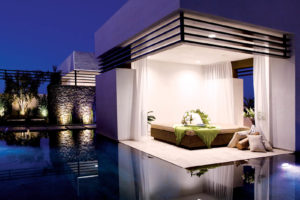
While many manufacturers concentrate on making smart products that give people convenient and luxurious control over functions in their homes and businesses, others are finding ways to make the outdoors equally responsive and comfortable to lifestyles in the Internet of Things age.
A robotics company in Pasadena, Calif., is, in fact, throwing all its weight behind a sole product, which it understatedly refers to as “a parasol.”
Even calling the ShadeCraft™ SUNFLOWER™ a parasol on steroids barely scratches the surface of its capabilities. Far from just providing shade, the Sunflower opens and closes itself; automatically tilts as it tracks the sun; collects solar energy; monitors the environment and reports stats that include air quality and the UV index (so you know what you’re saving your skin from under that shade); plays your music through a pair of Bluetooth-enabled Harman Kardon speakers; includes a 360-degree, motion-detecting, high-definition camera; features LED lights for evening ambiance; offers Wi-Fi, Bluetooth, and cellular connectivity; charges external devices; integrates itself into otherwise enabled smart homes; and responds to voice control. As one ShadeCraft video notes, “You can touch it, but you don’t have to.”
“What a great technology. It is expensive, but at some point that technology is going to be easier and more affordable. Concepts like that are market driven,” says Dee Duncan, CEO/president of fabric
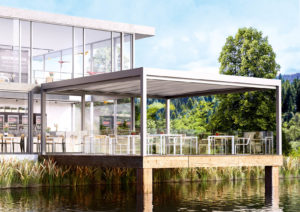
distributor and manufacturer Keyston Bros. of Roswell, Ga. He saw ShadeCraft’s product at the lodging industry’s BITAC® Purchasing & Design West event last fall.
“The hotel industry over the last four years has exploded with the advent of new products,” he notes, adding that Keyston Bros. recently landed a contract for the cabanas and poolside seating at The Cosmopolitan in Las Vegas. “Across the industry, there has been a shift in design to make things more like home. They are trying to create an enhanced experience from an outdoor perspective. When guests return home, they try to find out how they can use the same technology on a daily basis.”
Value for value
After a year of introducing its prototype Sunflower at trade shows, ShadeCraft began taking deposits in January for fall deliveries of the limited quantity being produced this year.
“Our target customers are anyone who enjoys the outdoors and may use Sunflower in a home or garden setting. We have received interest from the hospitality, parks and outdoor entertainment, and healthy-living industries,” COO Sarahgrace Kelly says. “The sleek design and cutting-edge technology appeal to those who want to listen to their favorite music outdoors or access the onboard camera while away from home. Others are drawn to the automation once they realize they will never have to hand-crank, tilt or lug shade around their yard ever again. The fact that all of Sunflower’s features are powered by solar energy is an important factor for those who are energy conscious.”
The SmartShade™ companion app allows users full control of the Sunflower’s functions, as well as the ability to set alerts and notifications.
Alberto Tanzi, president of Corradi USA Inc. in Carrollton, Texas, notes that the Italian-headquartered Corradi (whose website bills the company as “the outdoor alchemist”) invented and patented the first retractable-roof pergola in 1998.
“When we introduced it here in 2010, we offered five systems. Today our Dallas factory manufactures 13 systems. If you count the ones we’ve customized, we have a few dozen configurations,” Tanzi says. Originally a wood structure, Pergotenda® is now also available in aluminum and with a range of fabrics and features that include remote-controlled, orientable blades to regulate sunlight and ventilation; side screens; speakers; and a dimmable RGB (red–green–blue) system of LED lighting. In 2017, Corradi introduced the bioclimatic Maestro line with integrated gutters and drainpipe pillars.
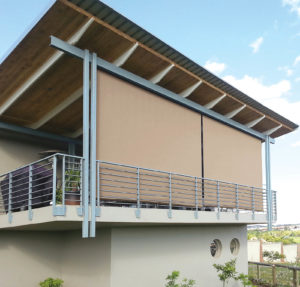
“The beauty of Pergotenda is that you can paint whatever picture you want,” Tanzi says. “It’s a very versatile system, and most of the components can handle 10 to 15 times the worst wind, rain and snow conditions they likely will be exposed to during their lifespan.”
Phifer Inc. of Tuscaloosa, Ala., manufactures shading and privacy fabrics used extensively in luxury and high-tech performance systems, particularly with its line called SunTex®—a vinyl-coated polyester mesh that is mildew- and fade-resistant and offers Microban® antimicrobial protection.
Phifer’s largest concentration of residential customers live in upscale neighborhoods and hot-weather climates. In small commercial and restaurant applications, the company sees “a growing trend for zip-screen technology that incorporates premium insect-screen products such as Phifer TuffScreen®,” says Andrew Caldwell, corporate market manager for sun control products.
“The growing outdoor-living trend and demands from the market are driving Phifer and our shade-manufacturing customers to meet higher fabric and electronic specifications,” he adds. “Examples include wider-width and lighter-weight fabrics that can be railroaded across 15- to 20-foot openings. Improvements in motor technology have largely contributed to shade-product versatility and will continue to be an important factor in the significant growth we anticipate in this market.”
Corradi USA has seen bigger growth in the commercial market, mainly because a Pergotenda roof can cover about 1,300 square feet—the size of a restaurant or bar patio that would otherwise require 15 umbrellas to shade customers, Tanzi says. “We have joined Pergotenda systems to create a four-season seating section. One of our systems for a restaurant can pay for itself in six to nine months.
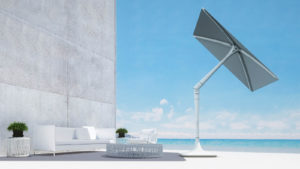
“When it comes to the residential community, homeowners don’t have a return on investment other than increasing the value of their homes,” he continues. “With accessories, a 20-by-15-foot system costs $30,000 to $40,000.”
According to Tanzi, retractable-roof pergolas were basically unknown in the United States when Corradi USA entered the scene. “We started targeting architects, and we see our efforts paying off,” he says. “On my table now I have five or six blueprints from architects.
“Architects are our advocates,” he adds. “They take an approach beyond cost.”
Corradi’s website offers a downloadable, 30-page architectural guide that includes product specifications. The company exhibits at architecture-related trade shows.
“[The American Society of Landscape Architects annual meeting and expo] is the best show for us because it’s more about exteriors,” Tanzi says.
“Architects have interior design firms that work with them, and they are the ones talking about color and performance,” says Duncan, whose company marks its 150th anniversary in 2018. “We have divisions called KB Contract and Keyston Outdoor to work with designers and specifiers.”
Educating the consumer
Compared to European citizens, whose lifestyles revolve around the outdoors, American consumers with a traditionally more insular culture are discovering the beauty of exterior living spaces. This suggests an opportunity for companies to develop ever-greater products using technology to make outside environments as comfortable as inside.
“The sale of our products is about 50-50 commercial–residential in Italy. In the United States, the ratio is 95 to 5, commercial to residential,” Tanzi says. “The Dallas–Fort Worth area has more single-family homes than in all of Italy. Of its 1.4 million homes, at least half of them have a patio and pool, and 10 to 15 percent are million-dollar-plus properties.”
The challenge for manufacturers and sellers appears to lie in educating consumers about the true value of their outdoor products.
“If you want to cover your patio, you can get a retractable awning for $4,000,” Tanzi says. “So when our dealers try to sell one of our systems, which cost four to five times as much, it is crucial that they master the knowledge to explain the differences in the amount of structure, the technology and the features/benefits.
“It is really important to educate and guide the consumer. Ultimately, it is up to whoever is in front of the end user to do that,” he adds. “We are always trying to help our dealers explain things to make sure they point out features—and, just as importantly, limitations.”
Style with substance
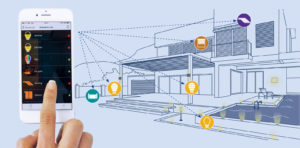
While others focus on the bells and whistles of smart technology, Duncan stresses the importance of smart design. “Why does an outdoor awning have to be boring?” he asks, adding that Keyston Bros. has been working with manufacturers to expand color, texture and pattern options with coatings
that provide performance features such as water repellency.
In addition to working with industry-leading manufacturers such as Glen Raven Inc., Keyston Bros. has developed its own high-performance fabrics. Its PVC-coated vinyl Olympus™ tests at 1.8 million double rubs, compared to the standard for high-density commercial fabrics of 30,000-plus double rubs. The company’s vinyl Coolshade features extreme UV resistance as well as mildew and high-abrasion resistance and easy-to-clean properties.
In addition to multiple stains and powder-coating colors for wood and aluminum frames, Corradi offers a variety of fabric options (including textiles from Phifer, Tempotest USA and Serge Ferrari). But, Tanzi notes, 80 to 90 percent of Pergotenda buyers opt for the company’s proprietary Eclissi: a four-layer, PVC-coated vinyl blackout fabric that reflects 95 percent of solar heat gain.
“Phifer has expanded its offering of rich, design-oriented options, which has attracted more outdoor-living designers and architects to specify fabric-based products and systems to match their clients’ overall color scheme and plan,” Caldwell says. “Because fabric is a very high percentage of the cost of most shading-related products, impeccable quality is the number one expectation among fabricators and their customers. Ease of cleaning and long-term performance backed by a warranty from the fabric manufacturer are critical.”
ShadeCraft uses Glen Raven’s UV-protective, water-repellent and fade-and stain-resistant Sunbrella® fabric for the canopy and integrates solar panels into the canopy blades. The Sunflower is designed so that consumers can easily switch out the fabric if they desire a different color.
“Our goal is to integrate solar-powered textiles into future products as the technology improves,” Kelly says. “Consumers are always looking for comfort and convenience. The Internet of Things is growing at a rapid pace. As a robotics company, we look to our partners at Glen Raven for their expertise in the future of the textile industry. We are excited to be working with them on innovative textile solutions for future ShadeCraft products.”
“The customer is looking for everything,” Duncan says. “They’re looking for first-class, performance-enhanced design.” He notes that Keyston Bros. introduced seven “more vivid, truer colors” of Coolshade at IFAI Expo 2017 last October.
“If the technology is there and the design is there, that is what drives a product over the hump [to sales],” he says.
Janice Kleinschmidt is a magazine writer and editor based in Palm Springs, Calif.
Much like 40 thieves in a fictional world could open a secret den by uttering two words, today’s homeowner can retract a patio roof or lift a screen with a similarly brief command beginning “Alexa.”
Or, one could take a luxuriously passive approach and let smart technology determine when sun, wind and rain conditions call for a change. And even those automated parameters are within control.
“Somfy sensors can be set on a scale of one to nine. If a homeowner finds the setting too sensitive, they can change it,” says Maud Demurge, marketing manager for Somfy Systems Inc. of Dayton, N.J., a leader among companies making radio-controlled motors to automate shading products.
Continuing the “intuitive” nature of motors, in January Somfy introduced obstacle detection to prevent a screen lowering onto objects like a chair (or pet!). Another recent development is Somfy’s myLink™ app, which enables consumers to manage shade structures remotely from smart phones or home voice controls (e.g., Amazon’s Alexa).
“We have a team working with architects around the United States, so they know the benefits and promote [Somfy motors]. We are seeing more and more premium shade structures,” Demurge says.
Headquartered in Italy, Teleco Automation S.R.l. specializes in the integration of remote-controlled products and custom LED solutions for outdoor structures.
“Consumers expect their devices to be ‘smart’ enabled,” says Mark San Martin, managing director of Teleco Automation Oceania in Coomera, Australia. “Being able to offer receivers, dimmers and controllers integrated into a central system with an easy-to-follow graphic user interface is a must for any modern manufacturer.”
Australians, he notes, are adding outdoor entertaining spaces to their homes. In the commercial arena, San Martin says, “The rise of TV foodie shows and an increase in expendable incomes have people heading to restaurants and cafés in droves. Smart business owners recognize the requirement for extra seating, and outdoor areas are an obvious solution. Ambiance can be created with dimmable lighting, ventilation and heating.
“Home automation systems enjoyed huge success here for many years, but users were overwhelmed with their complexity and underwhelmed each time they had to pay for a systems programmer to make changes,” he continues. “Informed and educated consumers want reliability and simplicity.”
 TEXTILES.ORG
TEXTILES.ORG


